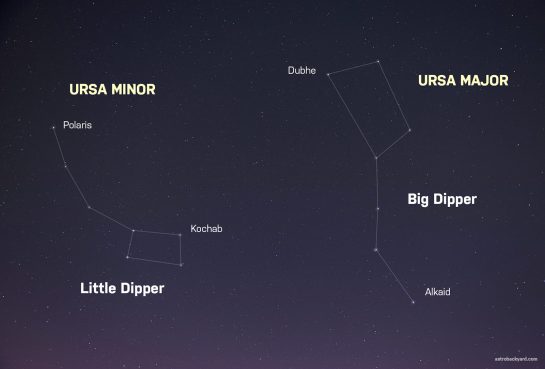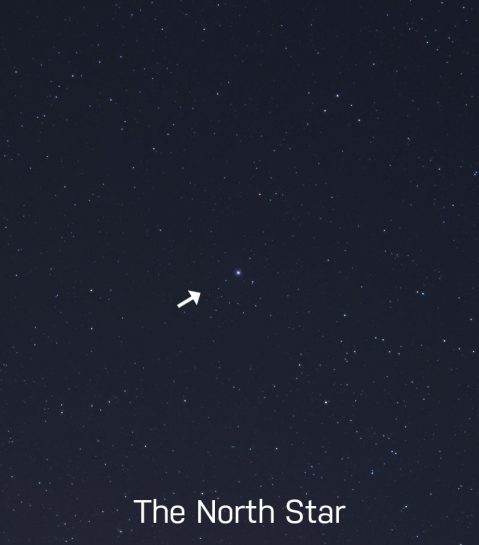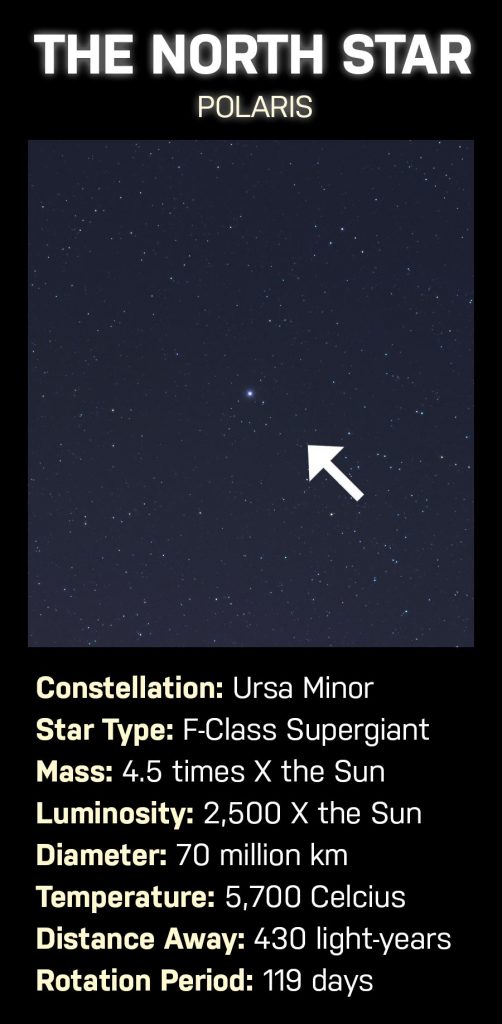How Many More Years Till Polaris Will Be Our Guiding North Star Again
What is the Northward Star?
The Northward Star is Polaris, located in the constellation Ursa Pocket-size. Information technology does not sit directly on the World'south n celestial pole, but it is very shut. In the northern hemisphere, Polaris is easy to place using the Lilliputian Dipper every bit a reference.
The stars and constellations in the night sky appear to rotate around the North Star throughout the year. A mutual misconception most the North Star is that information technology is the brightest star in the sky, but that is non true.

Polaris, or commonly known every bit The North Star is located almost directly above the North Angelic Pole, marking the style due n.
Polaris is not the brightest star in the dark heaven. Still, it is hands located making it a reliable judge of North for travelers without a compass.
In this article, I'll explain how to detect the Due north Star is in the dark sky and some interesting facts about World'south pole star.
The North Star: Polaris
- Constellation: Ursa Pocket-size
- Star Type: F-Grade Supergiant
- Mass: 4.5 times the mass of the Sun
- Luminosity: 2,500 times brighter than the Sun
- Diameter: 70 million km (fifty 10 the Sunday)
- Temperature: 5,700 Celcius
- Distance From Earth: 430 light-years
- Rotation Menstruum: 119 days
- Alternate Names: Polaris A, Blastoff Ursae Minoris, Pole Star, N Star

Equally y'all travel n, Polaris climbs higher in the heaven. If y'all go every bit far north as the North Pole, Polaris volition announced directly overhead. As y'all travel southward, Polaris drops closer to the northern horizon.
From the equator, Polaris sinks to the horizon and cannot be seen from the South of the equator. In the Northern Hemisphere, finding Polaris means you know the management north.
Fifty-fifty when the total moon obscures the sky, the North Star is relatively easy to come across. Polaris' position is RA: 2h 31m 48.7s, dec: +89° 15′ 51″.
The following video provides a bones overview of how to locate the North Star. A little farther down the post, I've included a really simple step-by-stride guide.
Discover the Little Dipper
Polaris is piece of cake to find if you can first locate the Footling Dipper, Ursa Minor.
Polaris lies at the end of the handle in the Petty Dipper. Polaris tin can also be located by finding the Big Dipper, Ursa Major.
To locate Polaris, all you lot have to do is to find the Big Dipper pointer stars Dubhe and Merak. These 2 stars outline the outer part of the Big Dipper's basin. Draw a line from Merak through Dubhe, and follow straight to Polaris, besides as the little dipper.
The Big Dipper lies below the piffling dipper and their handles betoken in opposite directions.
The Big Dipper, like a great large hour hand, goes a total counter-clockwise circle around Polaris in ane day.
Even though the Large Dipper travels effectually Polaris all night long, the Big Dipper arrow stars always point to Polaris on any mean solar day of the year, and at any time of the night.
How to Find the North Star
The following steps will assist y'all locate the North Star in the northern hemisphere heaven. Information technology is not difficult to notice Polaris, equally long as it sits high enough in the sky from your latitude, and obstructions such as large trees are not blocking your view.
- Locate the Large Dipper (7 stars)
- Observe the two bright stars that form the side of the basin reverse to the tip of the handle
- Depict an imaginary line through these two brilliant stars
- Extend the line until you attain a star of similar brightness (about v ten the altitude of these ii stars
- The bright star establish here is Polaris, the North Star
You can too detect the N Star by locating the tip of the Petty Dipper's handle, but this asterism can be difficult to find in the city. The Lilliputian Dipper is often referred to as the "Host of the North Star".
The amount of local low-cal pollution in your location can make seeing stars difficult. You lot can find out where your backyard falls in the Bortle Scale using this guide.

Amateur astronomers and astrophotographers must empathize how to discover the North Star to align their telescopes. Polar alignment is a critical stride of the procedure when using an equatorial telescope mount.
Once the mounts polar axis is aligned with the n celestial pole, the telescope tin can accurately runway the apparent move of the stars across the night heaven in the sidereal rate.
Will the North Star Change?
Polaris marks the center of Nature'southward grandest celestial clock. However the North Star has not always been, nor will it always be the Pole Star.
This is because the Earth'due south axis changes slightly over time, and stars move in relation to each other over time.
In the twelvemonth 3000 B.C.Due east, the Due north Star was a star different star called Thuban (also known as Alpha Draconis).
In about 13,000 years from our current date, the precession of the rotation axis will mean that the bright star Vega will go the North Star.

How Far Away is Polaris?
Information technology is estimated that Polaris' distance is roughly 430 lite-years away. The single signal of low-cal that nosotros run across as Polaris is actually a triple star arrangement; three stars orbiting a mutual centre of mass.
The chief star, Polaris A, is a supergiant more than 2 thousand times brighter than our dominicus. The next closest companion is Polaris Ab, a master-sequence star.
Polaris Ab orbits 2 billion miles from Polaris A. Much farther abroad from the offset 2, is the third companion Polaris B. Polaris B is located approximately 240 billion miles from Polaris A.
These two companion stars are the same temperature equally Polaris A, however, they are actually dwarf stars.
Why Polaris is so Fascinating
By watching the motion of Polaris A's companion star, Polaris Ab, astronomers expect to learn non only the stars' orbits but also their masses. Measuring the mass of a star is ane of the nearly hard tasks.
Astronomers want to determine the mass of Polaris accurately because information technology is the nearest Cepheid variable star; a type of star that pulsates radially, varying in both bore and temperature and producing changes in brightness with a well-defined stable period and amplitude.
Cepheid variable stars tin can be used to measure the distance to galaxies and the expansion rate of the universe. This is why it is and then of import to sympathize their physics and evolution.
The most important part of this process is knowing a Cepheid'due south mass. The North Star (Polaris) is a Cepheid variable, but its periodic variations in brightness are steadily decreasing in aamplitude. This has been observed to be the case for the last hundred years.
"Around the beginning of the 20th Century, Polaris' brightness fluctuated every 4 days by 10%. Only ten years agone this variation had dropped to ii%, leading astronomers to believe this steady decline in the variability of the star was about to end.
That was until recent observations uncovered an increase in variability to iv%. Polaris is an odd star in that it is a Cephid variable with a failing variability, and now astronomers are baffled as to why the brightness fluctuation has been revived.
The NASA'due south Hubble Space Telescope has been able to have photographed the shut companion of Polaris for the showtime fourth dimension." – Heart for Astrophysics.
The researchers plan to continue observing the Polaris arrangement for several years. During that fourth dimension, the movement of the small companion in its 30-year orbit effectually Polaris A, should be detectable.
The ultimate goal is the get an authentic mass for Polaris by measuring the motion of the companion, Polaris Ab in its orbit.

Polaris and Comet Lovejoy (NASA APOD) by Rogelio Bernal Andreo.
Interesting Facts Well-nigh Polaris:
- Polaris is only visible in the northern hemisphere
- Polaris has been a visual aid to navigators and astronomers for centuries
- Polaris is a 3-star system (Supergiant Polaris A and ii smaller companions)
- The companion stars (Polaris Ab and Polaris B) are both xanthous-white dwarfs
- Polaris is the brightest star in Ursa Minor
- Polaris is the only star in the night sky that appears to remain stationary
- Polaris has been aligned above the north angelic pole for around 2,000 years
Helpful Resources:
- Facts about the Polaris Star (SolarSystemQuick.com)
- NASA APOD October half dozen, 1999 – Polaris: The North Star
- Is the North Star the Brightest Star? CSMonitor.com

Source: https://astrobackyard.com/the-north-star/
0 Response to "How Many More Years Till Polaris Will Be Our Guiding North Star Again"
Post a Comment